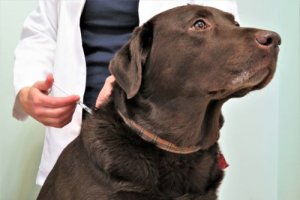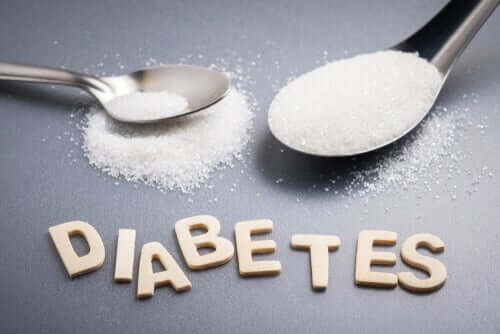The Care and Diet of Diabetic Dogs


Written and verified by biochemistry Luz Eduviges Thomas-Romero
In diabetic dogs, the level of insulin they produce is insufficient to metabolize glucose. Remember that insulin is a hormone that takes glucose from the blood and transports it to the interior of the body’s cells. Here, the body uses it as energy.
As a result of insufficient insulin production, the concentration of glucose in an animal’s blood increases. On occasions, it can reach levels where the kidneys stop filtering urine.
The signs and symptoms that appear in diabetic dogs
It’s important to understand that in diabetes the loss of glucose in urine takes water with it. This occurs through a process called osmosis. As a result, the animal produces greater volumes of urine than usual. This excessive loss of water in the urine leads to thirst and a greater intake of water.
So, the first clinical signs of diabetes mellitus in animals are:
- Polyuria (excessive urination)
- Polydipsia (excessive water consumption)
What’s more, diabetic dogs tend to lose weight because their bodies break down their fat and protein reserves–muscle–in order to produce glucose and ketones–an alternative combustion–in the liver. Furthermore, other clinical signs of diabetes can include diabetes, polyphagia (increased appetite), intolerance to exercise, and recurrent infections.

The objectives of therapy for canine diabetes
Essentially, as the owner of a dog with diabetes, you need to understand that there are three main objectives when it comes to treatment:
- The resolution of all medical signs and symptoms. Here we’re referring to those we mentioned above, with the exception of cataracts. So, blindness as a result of the formation of cataracts occurs in most diabetic dogs. However, this condition doesn’t depend on glycemic control.
- Avoiding hypoglycemia induced by insulin. Insulin is the basis of the treatment of diabetic dogs and a conservative focus on insulin therapy is crucial. Most dogs that have diabetes require insulin injections two times a day in order to keep their clinical symptoms under control. However, your dog’s veterinarian will determine the exact dose.
- Resuming the animal’s normal lifestyle and exercise level. While lethargy is typical in diabetic dogs, it tends to resolve itself quickly. Therefore, dogs usually become more active and sensitive shortly after starting insulin therapy.
Why is it so important to control insulin-induced hypoglycemia?
Severe hypoglycemia (low blood sugar) resulting from an overdose of insulin can cause irreparable brain damage, blindness, convulsions, and death. The clinical signs of this condition include weakness, restlessness, heart palpitations, anorexia, and diarrhea.

Dietary recommendations for diabetic dogs
Ideally, diabetic dogs should eat just before the moment when the activity of the insulin administered is expected to peak. So, pet owners should commit to feeding their diabetic dogs immediately after administering their insulin injections.
This practice will simplify your dog’s treatment regimen considerably at home. At the same time, it will allow you to maintain better glycemic control. What’s more, many owners prefer this method because it causes their dogs to feel rewarded for putting up with their injections.
Table 1. Summary of the dietary recommendations for diabetic dogs:
| Dietary factor | Recommendation |
| Calorie intake | Enough to achieve and maintain optimal conditions in the body. |
| Primary nutritional requirements | Food should be flavorful and nutritionally balanced. It’s important to be consistent. Provide a standard number of calories and feed your animal after each insulin administration. |
| Other nutritional recommendations | Increase the content of complex carbohydrates with a high percentage of insoluble fiber in foods. At the same time, reduce fat content, especially in the case of concurrent pancreatitis. |
| Feeding times | Ideally, the postprandial period should coincide with the period of maximum exogenic insulin activity. |
| Diabetic dogs with a concurrent disease | The nutritional requirements of any concurrent disease should take priority over the dietary treatment of diabetes. |
In diabetic dogs, the level of insulin they produce is insufficient to metabolize glucose. Remember that insulin is a hormone that takes glucose from the blood and transports it to the interior of the body’s cells. Here, the body uses it as energy.
As a result of insufficient insulin production, the concentration of glucose in an animal’s blood increases. On occasions, it can reach levels where the kidneys stop filtering urine.
The signs and symptoms that appear in diabetic dogs
It’s important to understand that in diabetes the loss of glucose in urine takes water with it. This occurs through a process called osmosis. As a result, the animal produces greater volumes of urine than usual. This excessive loss of water in the urine leads to thirst and a greater intake of water.
So, the first clinical signs of diabetes mellitus in animals are:
- Polyuria (excessive urination)
- Polydipsia (excessive water consumption)
What’s more, diabetic dogs tend to lose weight because their bodies break down their fat and protein reserves–muscle–in order to produce glucose and ketones–an alternative combustion–in the liver. Furthermore, other clinical signs of diabetes can include diabetes, polyphagia (increased appetite), intolerance to exercise, and recurrent infections.

The objectives of therapy for canine diabetes
Essentially, as the owner of a dog with diabetes, you need to understand that there are three main objectives when it comes to treatment:
- The resolution of all medical signs and symptoms. Here we’re referring to those we mentioned above, with the exception of cataracts. So, blindness as a result of the formation of cataracts occurs in most diabetic dogs. However, this condition doesn’t depend on glycemic control.
- Avoiding hypoglycemia induced by insulin. Insulin is the basis of the treatment of diabetic dogs and a conservative focus on insulin therapy is crucial. Most dogs that have diabetes require insulin injections two times a day in order to keep their clinical symptoms under control. However, your dog’s veterinarian will determine the exact dose.
- Resuming the animal’s normal lifestyle and exercise level. While lethargy is typical in diabetic dogs, it tends to resolve itself quickly. Therefore, dogs usually become more active and sensitive shortly after starting insulin therapy.
Why is it so important to control insulin-induced hypoglycemia?
Severe hypoglycemia (low blood sugar) resulting from an overdose of insulin can cause irreparable brain damage, blindness, convulsions, and death. The clinical signs of this condition include weakness, restlessness, heart palpitations, anorexia, and diarrhea.

Dietary recommendations for diabetic dogs
Ideally, diabetic dogs should eat just before the moment when the activity of the insulin administered is expected to peak. So, pet owners should commit to feeding their diabetic dogs immediately after administering their insulin injections.
This practice will simplify your dog’s treatment regimen considerably at home. At the same time, it will allow you to maintain better glycemic control. What’s more, many owners prefer this method because it causes their dogs to feel rewarded for putting up with their injections.
Table 1. Summary of the dietary recommendations for diabetic dogs:
| Dietary factor | Recommendation |
| Calorie intake | Enough to achieve and maintain optimal conditions in the body. |
| Primary nutritional requirements | Food should be flavorful and nutritionally balanced. It’s important to be consistent. Provide a standard number of calories and feed your animal after each insulin administration. |
| Other nutritional recommendations | Increase the content of complex carbohydrates with a high percentage of insoluble fiber in foods. At the same time, reduce fat content, especially in the case of concurrent pancreatitis. |
| Feeding times | Ideally, the postprandial period should coincide with the period of maximum exogenic insulin activity. |
| Diabetic dogs with a concurrent disease | The nutritional requirements of any concurrent disease should take priority over the dietary treatment of diabetes. |
All cited sources were thoroughly reviewed by our team to ensure their quality, reliability, currency, and validity. The bibliography of this article was considered reliable and of academic or scientific accuracy.
- Rucinsky, R., Cook, A., Haley, S., Nelson, R., Zoran, D. L., & Poundstone, M. (2010). AAHA diabetes management guidelines for dogs and cats. Journal of the American Animal Hospital Association, 46(3), 215-224.
- Fleeman, L. M., & Rand, J. S. (2001). Management of canine diabetes. Veterinary Clinics: Small Animal Practice, 31(5), 855-880.
- Hoenig, M., Laflamme, D. P., Klaser, D. A., Singer, M. J., & Ferguson, D. C. (2001). Glucose tolerance and lipid profiles in dogs fed different fiber diets. Journal of veterinary pharmacology and therapeutics, 2, 160-169.
- Rand, J. S., Fleeman, L. M., Farrow, H. A., Appleton, D. J., & Lederer, R. (2004). Canine and feline diabetes mellitus: nature or nurture?. The Journal of Nutrition, 134(8), 2072S-2080S.
This text is provided for informational purposes only and does not replace consultation with a professional. If in doubt, consult your specialist.








